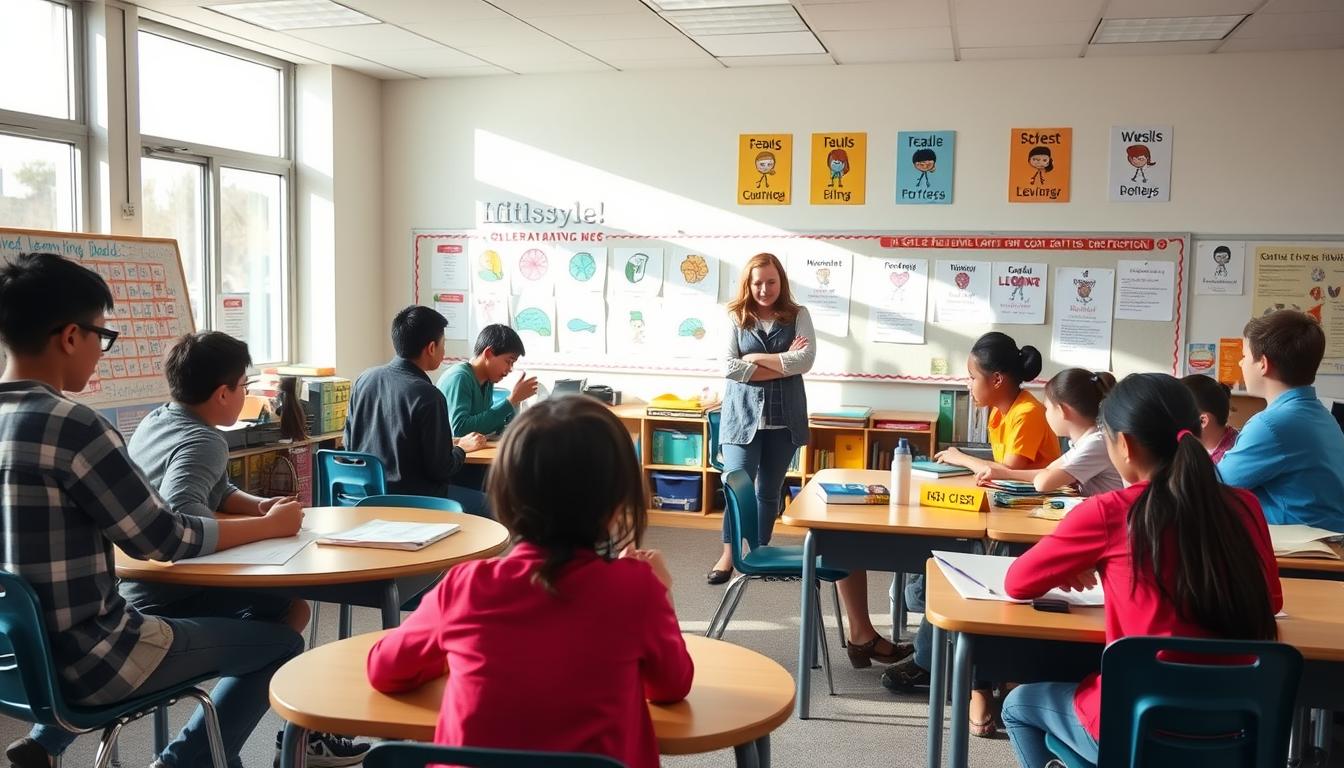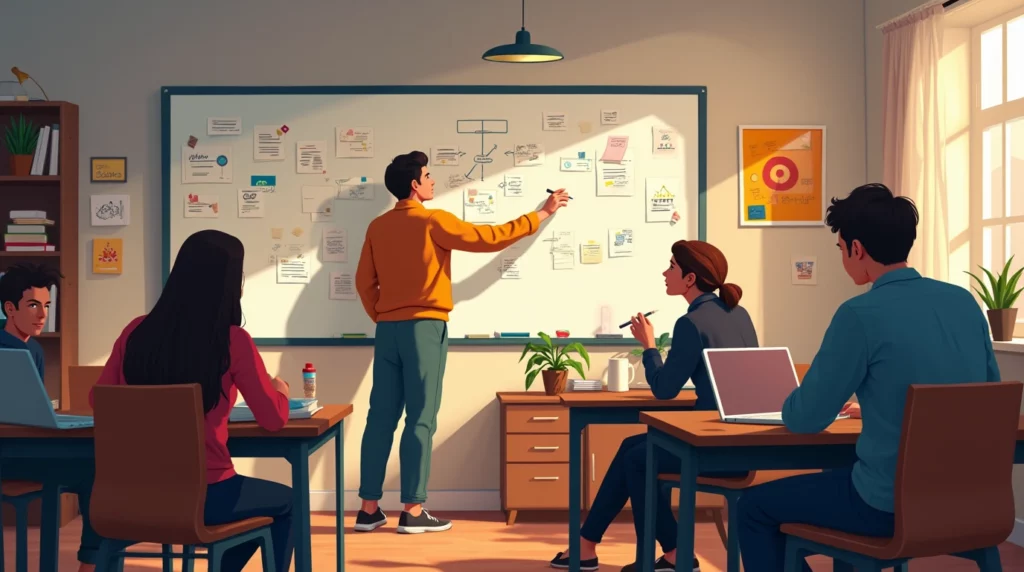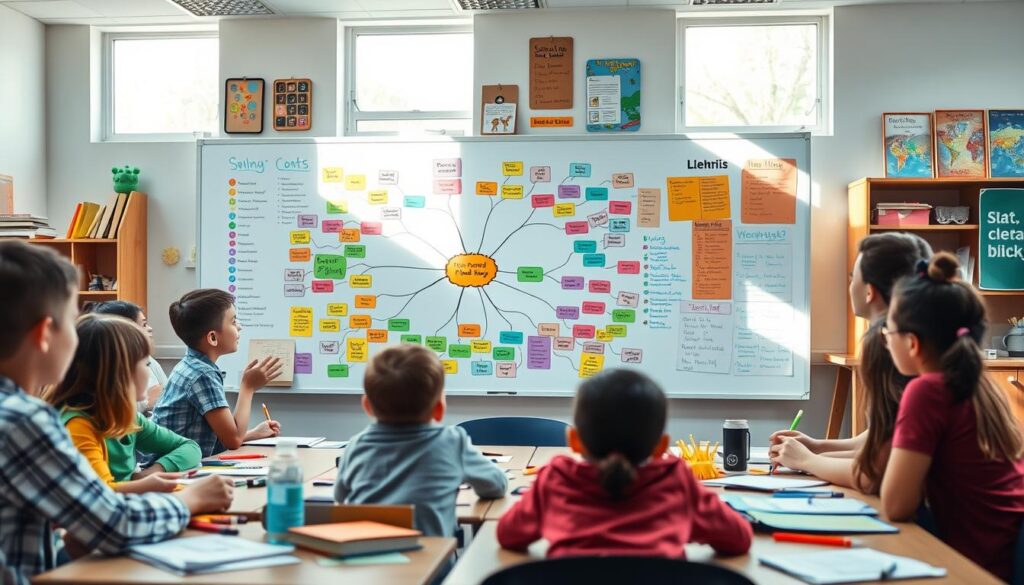Differentiated Instruction: A Modern Educational Approach

Table of Contents
I believe that differentiated education is very important. Its definition is to provide equal educational opportunities for everyone. This makes it different from traditional education, which focuses on the individual needs of each student.
I think modern education needs a philosophy like differentiated education. This type of education allows students to benefit from diverse learning experiences. This helps improve the quality of education in the Kingdom.
The Concept of Differentiated Instruction and its Importance in the Educational System

In the modern world, the definition of differentiated instruction is very important. It focuses on meeting the unique needs of each student. This differs from traditional education, which relies on a one-size-fits-all approach.
The importance of differentiated instruction lies in its ability to improve educational outcomes. It allows students to learn in an environment that suits them.
The significance of differentiated instruction depends on its ability to meet individual needs. This leads to improved academic performance. It also helps develop skills like critical thinking.
- Meeting the individual needs of students
- Improving academic performance
- Developing critical thinking and problem-solving skills
In the modern era, differentiated instruction has become essential. It allows students to learn in an interactive and developing environment. Therefore, understanding the definition and importance of differentiated instruction is vital.
Theoretical Foundations of Differentiated Instruction

The theoretical foundations of differentiated instruction are based on understanding how individuals learn. These theories include concepts like reception learning and discovery learning. These concepts emphasize the importance of students interacting with information in an interactive and continuous way.
Studies show the impact of the theoretical foundations of differentiated instruction on the quality of education. Examples of these foundations include:
- Reception Learning Theory: Focuses on presenting information in an organized and interconnected manner.
- Discovery Learning Theory: Encourages students to discover information themselves through practical experiences.
By using these foundations, teachers can develop differentiated educational programs. These programs meet the needs of all students. This requires a deep understanding of differentiated instruction and its importance in improving the quality of education.
Therefore, the theoretical foundations of differentiated instruction are essential for achieving effective educational goals. By applying these foundations, we can develop educational programs that suit the needs of students. These programs contribute to improving the quality of education.
| Theoretical Foundations | Description |
|---|---|
| Reception Learning | Presenting information in an organized and interconnected manner |
| Discovery Learning | Encouraging students to discover information themselves |
Characteristics and Educational Goals of Differentiated Instruction
Differentiated instruction is distinguished by its core characteristics. It aims to provide an effective learning experience for every individual. The focus is on individual student needs to provide a personalized learning experience.
The core characteristics of differentiated instruction help achieve educational and pedagogical goals. These characteristics include:
- Focus on individual student needs
- Developing thinking and analytical skills
- Promoting independence and creative thinking
As for the goals of differentiated instruction, they aim for comprehensive student development. These goals include:
- Achieving academic excellence
- Developing social and personal skills
- Promoting values and cultural perspective
By using the characteristics of differentiated instruction and the goals of differentiated instruction, excellent educational outcomes can be achieved. This helps in the comprehensive development of students.
| Characteristics | Goals |
|---|---|
| Focus on individual student needs | Achieving academic excellence |
| Developing thinking and analytical skills | Developing social and personal skills |
| Promoting independence and creative thinking | Promoting values and cultural perspective |
Differentiated Instruction Strategies in the Classroom

In the classroom, various instructional strategies can be used to improve the quality of learning. These strategies include cooperative learning and project-based learning.
One of the most important differentiated instruction strategies is providing diverse learning opportunities for students. This can be achieved through the use of different educational resources, such as books and digital learning tools.
- Using technology in education
- Developing critical and analytical thinking skills
- Encouraging self-directed learning and active participation
It is important to apply differentiated instruction strategies in a way that suits each student. This can be achieved by assessing student needs and developing individualized learning plans.
Differentiated instruction strategies help improve the quality of learning and increase opportunities for success. Teachers should work to apply these strategies effectively.
| Differentiated Instruction Strategy | Description |
|---|---|
| Cooperative Learning | Students learn together and collaborate on projects |
| Project-Based Learning | Students learn by working on real-world projects and applying them |
The Teacher’s Role in Applying Differentiated Instruction
The teacher’s role is very important for the success of differentiated instruction. The teacher plays a key role in achieving educational goals. The teacher needs special skills to implement this approach.
The necessary teacher skills include the ability to plan and execute. The teacher must focus on designing learning plans that suit student needs. The teacher should be aware of students and their characteristics.
Necessary Teacher Skills
- Ability to plan and execute
- Ability to design educational plans that suit the needs of different students
- Ability to assess student performance and identify strengths and weaknesses
Thanks to these skills, the teacher can play an effective role in differentiated instruction. The teacher needs constant readiness to learn and develop. They must be able to adapt to changes in student needs.
Challenges of Implementing Differentiated Instruction and Their Solutions
In implementing differentiated instruction, schools face many challenges. These challenges include a lack of resources and infrastructure. There is also a lack of teacher training in differentiated instruction methods.
To overcome these challenges, we need appropriate differentiated instruction solutions for each school. These solutions can include training programs for teachers. Infrastructure development and providing diverse educational resources are also necessary.
It is important to mention that implementing differentiated instruction challenges requires cooperation. There must be a shared understanding among teachers, administrators, and students. This understanding is essential for providing a comprehensive and collaborative learning environment.
Here are some suggested solutions to address differentiated instruction challenges:
- Provide training programs for teachers on using differentiated instruction methods.
- Develop educational infrastructure to include modern technology and various educational tools.
- Diversify educational resources to meet the needs of all students.
By using these solutions, schools can overcome differentiated instruction challenges. This allows students to receive unique and specialized learning experiences.
Modern Differentiated Instruction Tools and Technologies
In our era, differentiated instruction tools have become an essential part of learning. These tools help improve the quality of education. They also make learning more effective and enjoyable.
Among these tools, we find differentiated instruction technologies that allow teachers to design personalized learning programs. These programs better meet the needs of students.
Differentiated instruction technologies use digital technology in classrooms. Computers, smartphones, and the internet can be used to enhance learning. Films and e-books can also be used to make learning more exciting.
Diverse Educational Media
- Educational films
- Educational TV programs
- E-books
- Educational applications
It is important to use differentiated instruction tools and differentiated instruction technologies effectively. Teachers should be aware of how to use these tools. The use of technology should be balanced with traditional activities to ensure a comprehensive learning experience.
Student Assessment in a Differentiated Instruction System
In a differentiated instruction system, student assessment is a fundamental part. This helps us understand their performance level and skills. This, in turn, helps improve the quality of education.
Different methods can be used to assess students, such as tests and exams, projects, and classroom activities. Assessment aims to improve student performance and increase their chances of success.
It is important for assessment to be fair and balanced. This ensures equal opportunities for everyone. Modern educational technologies help improve the assessment process.
| Assessment Method | Purpose |
|---|---|
| Tests and Exams | Assessing knowledge and skills |
| Projects and Classroom Activities | Assessing critical thinking and teamwork |
| Educational Software | Providing immediate and continuous feedback |
In a differentiated instruction system, student assessment is integral. Various methods should be used to ensure equal opportunities for all. Modern technologies should also be leveraged to improve the quality of education.
Successful Models in Applying Differentiated Instruction
Differentiated instruction models are very important for improving the quality of education. They provide exciting learning experiences. By studying differentiated instruction models, we can learn a lot to improve student performance.
differentiated instruction experiences are considered a fundamental part of educational development. Differentiated learning models have been applied in some schools. This has led to an improvement in student levels and increased their engagement.
Local Experiences
- Applying differentiated learning models in public schools
- Using technology to support differentiated instruction
- Developing educational programs that suit student needs
Global Experiences
Differentiated instruction experiences in countries like the United States and Australia offer successful models. These experiences highlight the importance of applying differentiated instruction models to improve the quality of education.
By studying differentiated instruction experiences, we can develop educational models that suit the needs of students . These models will help improve the quality of education and increase student success opportunities.
The Future of Differentiated Instruction

the future of differentiated instruction is very important. This type of education aims to provide equal educational opportunities for every person, regardless of their background or abilities. Differentiated instruction is believed to play a significant role in improving education in the Kingdom.
Technology plays a major role in the future of differentiated instruction. It can make education more interactive and enjoyable. Examples include using electronic learning platforms and educational software that allow students to learn better.
Developing teachers’ skills is a fundamental part of the future of education. Teachers need training to use modern teaching methods. This helps improve the quality of education and increase opportunities for student success.
These are some key points for the future of differentiated instruction :
- Developing curricula to suit the different needs of students.
- Using technology to enhance learning experiences.
- Developing teachers’ skills to use modern teaching methods.
- Providing individual support for students to increase their chances of success.
Ultimately, the future of differentiated instruction looks bright. It aims to provide equal educational opportunities and improve the quality of education. Thanks to technology and the development of teacher skills, these goals can be achieved, ensuring a better future for education in the Kingdom.
Integration of Differentiated and Distance Learning
Technology is rapidly evolving, making the integration of differentiated instruction and distance learning essential. This makes it easier for students to access educational materials. It also aligns with their learning styles.
Integration mechanisms include using electronic learning platforms. It also relies on designing educational programs that suit students.
Integration Mechanisms
Technology helps integrate differentiated instruction and distance learning. Electronic learning platforms easily provide educational materials. They also organize classrooms.
Electronic communication tools enhance communication between teachers and students. This facilitates information exchange.
Benefits of Integration
The integration of differentiated instruction and distance learning improves the quality of learning. It increases access to education. It also reduces costs and makes studying more flexible.
Integration creates a more effective educational system. It suits the needs of students in the 21st century. This is a step towards improving education and increasing opportunities for success.
Practical Steps for Implementing Differentiated Instruction
To achieve differentiated instruction, specific steps must be followed. First, teachers must understand the philosophy of differentiated instruction. Then, they should analyze their students’ needs.
An important step is to provide a supportive learning environment. Digital technologies can be used to achieve this. Student performance should also be assessed, and necessary assistance provided.
Other steps include:
- Setting clear learning objectives
- Designing learning activities that suit student needs
- Using diverse teaching strategies
- Providing opportunities for participation in learning activities
Implementing differentiated instruction requires time and effort. However, it can lead to improved quality of education. Teachers and institutions should work together to ensure high-quality education.
Conclusion
In this conclusion, we highlight the most important points of differentiated instruction. We find that differentiated instruction plays a significant role in improving the quality of education. Considering the individual needs and abilities of students is a fundamental part of it.
In the future, we anticipate new developments in differentiated instruction. These developments will help improve the efficiency of education and better achieve the goals of the educational system. We hope that schools and teachers will benefit from the information here to effectively implement differentiated instruction.
FAQ
What is the concept of Differentiated Instruction?
Differentiated instruction aims to provide education tailored to each student. It relies on customizing content and activities according to each student’s needs.
Why has Differentiated Instruction become important in the modern era?
Differentiated instruction has become essential to respect the differences among students. It helps improve their academic outcomes and increase their learning potential.
What are the main differences between traditional education and Differentiated Instruction?
Traditional education relies on one content for all students, while differentiated instruction relies on customizing content according to each student’s needs.
What are the theoretical foundations upon which Differentiated Instruction is based?
Differentiated instruction is based on theories such as the theory of multiple intelligences. It also relies on learning style theories and the constructivist theory of learning.
What are the core characteristics of Differentiated Instruction?
Differentiated instruction is characterized by flexibility and a focus on individual differences. It uses diverse strategies, continuous assessment, and comprehensive plans.
What are the main strategies for Differentiated Instruction in the classroom?
Key strategies include cooperative learning and project-based learning. It also includes direct instruction, interactive activities, and alternative assessment.
What are the necessary teacher skills for applying Differentiated Instruction?
Teacher skills include good planning and diversifying strategies. It also requires classroom management and continuous analysis of student performance.
What challenges might face the implementation of Differentiated Instruction, and how can they be overcome?
Challenges may include weak technological infrastructure and increased workload for teachers. These can be overcome with continuous training and providing necessary resources.
What are the modern tools and technologies used in Differentiated Instruction?
Modern tools include interactive programs and digital applications. This also includes multimedia and electronic learning blogs.
How are students assessed in a Differentiated Instruction system?
Diverse assessment methods are used, such as pre-assessment and formative assessment. It also includes self-assessment to measure students’ achievement levels.
What are the successful models of Differentiated Instruction at the local and global levels?
Successful models exist in Saudi and international schools. These include successful experiences in the United States, Canada, and Australia.
What is the future of Differentiated Instruction?
Differentiated instruction is expected to grow . Education will develop thanks to government trends towards best practices.
How can Differentiated Instruction and distance learning be integrated?
Integration can be achieved by using electronic learning platforms. Content should also be diverse and adapted to student needs.
What are the practical steps for implementing Differentiated Instruction in schools?
The steps include analyzing student needs and setting learning objectives. Lessons should also be planned in a varied way and appropriate strategies implemented.



